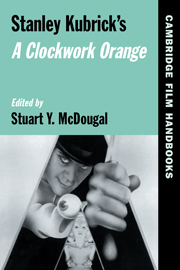12 results
List of Contributors
-
- Book:
- Stanley Kubrick's <I>A Clockwork Orange</I>
- Published online:
- 29 January 2010
- Print publication:
- 07 July 2003, pp xiii-xiv
-
- Chapter
- Export citation
A Glossary of Nadsat
-
- Book:
- Stanley Kubrick's <I>A Clockwork Orange</I>
- Published online:
- 29 January 2010
- Print publication:
- 07 July 2003, pp 141-150
-
- Chapter
- Export citation
REVIEWS OF A CLOCKWORK ORANGE, 1972
-
- Book:
- Stanley Kubrick's <I>A Clockwork Orange</I>
- Published online:
- 29 January 2010
- Print publication:
- 07 July 2003, pp -
-
- Chapter
- Export citation
Select Bibliography
-
- Book:
- Stanley Kubrick's <I>A Clockwork Orange</I>
- Published online:
- 29 January 2010
- Print publication:
- 07 July 2003, pp 163-166
-
- Chapter
- Export citation
Acknowledgments
-
-
- Book:
- Stanley Kubrick's <I>A Clockwork Orange</I>
- Published online:
- 29 January 2010
- Print publication:
- 07 July 2003, pp xi-xii
-
- Chapter
- Export citation
Filmography
-
- Book:
- Stanley Kubrick's <I>A Clockwork Orange</I>
- Published online:
- 29 January 2010
- Print publication:
- 07 July 2003, pp 151-162
-
- Chapter
- Export citation

Stanley Kubrick's A Clockwork Orange
-
- Published online:
- 29 January 2010
- Print publication:
- 07 July 2003
Introduction: “What's it going to be then, eh?”: Questioning Kubrick's Clockwork
-
-
- Book:
- Stanley Kubrick's <I>A Clockwork Orange</I>
- Published online:
- 29 January 2010
- Print publication:
- 07 July 2003, pp 1-18
-
- Chapter
- Export citation
Index
-
- Book:
- Stanley Kubrick's <I>A Clockwork Orange</I>
- Published online:
- 29 January 2010
- Print publication:
- 07 July 2003, pp 167-168
-
- Chapter
- Export citation
Contents
-
- Book:
- Stanley Kubrick's <I>A Clockwork Orange</I>
- Published online:
- 29 January 2010
- Print publication:
- 07 July 2003, pp ix-x
-
- Chapter
- Export citation
Frontmatter
-
- Book:
- Stanley Kubrick's <I>A Clockwork Orange</I>
- Published online:
- 29 January 2010
- Print publication:
- 07 July 2003, pp i-viii
-
- Chapter
- Export citation
Looking Backward, Looking Forward: MLA Members Speak
-
- Journal:
- PMLA / Publications of the Modern Language Association of America / Volume 115 / Issue 7 / December 2000
- Published online by Cambridge University Press:
- 23 October 2020, pp. 1986-2078
- Print publication:
- December 2000
-
- Article
- Export citation



